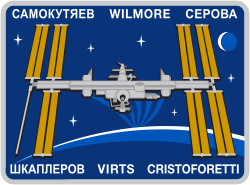Jelena Serova
| Jelena Serova (Елена Олеговна Серова) | |
 | |
| Kosmonaut | |
|---|---|
| Född | 22 april 1976 Ussurijsk, Ryssland |
| Tid i rymden | 167 dagar, 5 timmar, 44 minuter |
| Uppdrag | Sojuz TMA-14M, Expedition 41/42 |
| Uppdragsemblem | |
Jelena Olegovna Serova (ryska: Елена Олеговна Серова) född 22 april 1976 i Ussurijsk i Ryssland, dåvarande Sovjetunionen.[1] Hon antogs till den ryska kosmonaututbildningen år 2006.[2]
Hon var en av fem kosmonauter som hissade den ryska flaggan under invigningen av Olympiska vinterspelen i Sotji 2014.[3]
Hon var mellan september 2014 och mars 2015 medlem av Expedition 41 på Internationella rymdstationen. Hon blev därmed den första kvinnliga kosmonauten att besöka rymdstationen.[4]
Biografi
Serova föddes i Vozdvizhenka, en by som är en del av staden Ussuriysk i Fjärran Östern i Ryssland. Hon stannade i Vozdvizhenka fram till 1988. Serova åkte till Tyskland eftersom hennes far som var med i militären fick en förflyttning. Därefter kom hon till Moskva. Hon träffade där sin framtida make Mark vid Moscow Aviation Institute.[5]
I mars 2001 tog Serova examen från Aerospace Faculty of the Moscow Aviation Institute och kvalificerade sig som ingenjör. År 2003 tog hon examen från Moskvas statsakademi för instrumentteknik och information och blev kvalificerad som ekonom.[2]
Innan hon registrerades som kosmonaut hade Serova arbetat som ingenjör i andra kategorin för RSC Energia och i Mission Control Center.[6]
Serova valdes som testkosmonaut vid 30 års ålder i RKKE-14-gruppen i oktober 2006, medan hon arbetade som flygingenjör. Hon slutförde sin grundutbildning vid Star City 2009.[7]
Expedition 41/42

I slutet av 2011 tillkännagav ryska rymdorganisationens chef Vladimir Popovkin att Serova skulle flyga till den internationella rymdstationen, och förväntades tillbringa upp till sex månader i rymden med biofysik och medicinska experiment.[8]
Den 25 september 2014 reste hon ombord på rymdfarkosten Soyuz TMA-14M för att arbeta som flygingenjör för Expedition 41/42.[9][10]
Soyuz FG-raketen med TMA-14M-befälhavaren Aleksandr Samokutjajev, Jelena Serova och NASA-astronauten Barry E. Wilmore sköts upp från kosmodromen i Bajkonur.[11] Efter 6 timmar dockade rymdfarkosten med rymdstationens modul Poisk, och de tre rymdfararna välkomnades ombord.[12]
Den 11 mars 2015 återvände besättningen framgångsrikt till jorden efter 167 dagar i rymden.[13]
Rymdfärder
Referenser
- Den här artikeln är helt eller delvis baserad på material från engelskspråkiga Wikipedia, 28 november 2020.
Källor
- ^ Manned Astronautics - Figures & Facts
- ^ [a b] ”Serova, Yelena Olegovna” (på engelska). astronautix.com. http://www.astronautix.com/s/serova.html. Läst 28 november 2020.
- ^ Pearlman, Robert Z. (7 februari 2014). ”Sochi Winter Olympics Launch with Space-Flown Torch, Cosmonaut Flag-Bearers” (på engelska). space.com. https://www.space.com/24613-winter-olympics-2014-space-cosmonauts-ceremony.html. Läst 28 november 2020.
- ^ ”First Russian woman in International Space Station mission” (på engelska). BBC NEWS. 26 december 2014. https://www.bbc.com/news/world-europe-29372277. Läst 28 november 2020.
- ^ NASA (1 augusti 2014). ”Preflight Interview: Elena Serova”. NASA. Arkiverad från originalet den 26 oktober 2014. https://web.archive.org/web/20141026102800/http://www.nasa.gov/content/preflight-interview-elena-serova/. Läst 29 november 2020.
- ^ ”Elena Olegovna Serova” (på engelska). Energia. Arkiverad från originalet den 28 november 2020. https://web.archive.org/web/20201128072643/https://www.energia.ru/en/iss/iss39/serova.html. Läst 28 november 2020.
- ^ ”Serova, Yelena” (på engelska). spacefacts.de. 19 april 2018. http://www.spacefacts.de/bios/cosmonauts/english/serova_yelena.htm. Läst 28 november 2020.
- ^ O'Meara, Stephen; Dasch, E. Julius (på engelska). A Dictionary of Space Exploration. Oxford University Press. https://books.google.se/books?id=7JRqDwAAQBAJ&pg=PT586&lpg=PT586&dq=biophysics+and+medical+experiments+yelena+serova&source=bl&ots=gu1-fSnfXh&sig=ACfU3U1qkzGft3SxIGppCXoxWVOGKptP7A&hl=sv&sa=X&ved=2ahUKEwj95-7WkqXtAhXxo4sKHa6UDCMQ6AEwEHoECAUQAg#v=onepage&q=biophysics%20and%20medical%20experiments%20yelena%20serova&f=false
- ^ ”Expedition 41” (på engelska). NASA. Arkiverad från originalet den 21 februari 2014. https://web.archive.org/web/20140221171343/http://www.nasa.gov/mission_pages/station/expeditions/expedition41/#.UqCGiuLX21c. Läst 28 november 2020.
- ^ ”Expedition 42” (på engelska). NASA. Arkiverad från originalet den 21 februari 2014. https://web.archive.org/web/20140221173020/http://www.nasa.gov/mission_pages/station/expeditions/expedition42/#.UqCGmOLX21c. Läst 28 november 2020.
- ^ ”Expedition 41/42 Launches, Arrives, and Enters the International Space Station” (på engelska). Nasa. 3 maj 2019. https://www.aerocontact.com/videos/4220-expedition-4142-launches-arrives-and-enters-the-international-space-station. Läst 28 november 2020.
- ^ Harwood, William (26 september 2014). ”Soyuz delivers three to space station” (på engelska). CBS NEWS. https://www.cbsnews.com/news/russia-soyuz-docks-international-space-station-iss-nasa-barry-butch/. Läst 29 november 2020.
- ^ ”NASA ISS On-Orbit Status 11 2015” (på engelska). spaceref.com. 12 mars 2015. https://spaceref.com/space-stations/nasa-iss-on-orbit-status-11-march-2015/. Läst 29 november 2020.
Media som används på denna webbplats
The Expedition 41 crew members have released their patch and have written some text to go along with it:
- "Portraying the road of human exploration into our vastly unknown universe, all elements of the Expedition 41 patch build from the foundation, our Earth, to the stars beyond our solar system. The focus of our six-month expedition to the International Space Station (ISS) is Earth and its inhabitants as well as a scientific look out into our universe. The distinguishing ISS solar arrays reach onward and serve as the central element, with the icon of an atom underneath representing the multitude of research onboard that will bring new discoveries for the benefit of humanity. The sun is rising over Earth's horizon, spreading its light along the road of human exploration. Equipped with the knowledge and inspiration gained from ISS, our successful multinational cooperation will lead human space exploration to the moon, Mars, and ultimately, the stars. We are Expedition 41. Join us for the adventure."
Russian cosmonaut Elena Serova, Expedition 41/42 flight engineer, is pictured during a familiarization training session in the Space Station Training Facility (SSTF) in the Jake Garn Simulation and Training Facility at NASA's Johnson Space Center.
Russian cosmonaut Elena Serova, Expedition 41 flight engineer, works with test samples from the Kaskad cell cultivation experiment in a glovebox in the Poisk Mini-Research Module 2 (MRM2) of the International Space Station.
The rectangular-shaped design portrays the International Space Station orbiting planet Earth with its solar array wings spread wide. Facing the sun with the lower left outboard solar array feathered, the left array portrays a prominent number "4" and the fully deployed arrays on the right form the Roman numeral version of "2," which signifies the two increment crews which, together, comprise the six-member international Expedition "42" crew. The crew and all supporting personnel around the world are also represented by the six stars adorning the sky around the complex.



